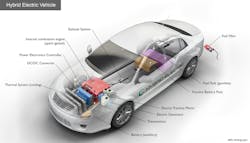What you will learn over the next three successive articles:
- The six different categories for alternative fueled vehicles
- Basic understanding how each type of alternative fuel vehicle is configured
- How to safely address and repair each type of alternative fueled vehicle.
Content brought to you by ABRN. To subscribe, click here.
Let's start with a raise of hands.
How many folks here have heard of alternative fuel vehicles? (I predict lots of hands being raised).
OK, how many of you really understand about the different categories of alt-fuel cars and trucks, how to safely and correctly disable, repair, and inspect before returning to your client? (Not as many hands, I would imagine).
Don't fret. The purpose of this article and the three or so to follow will be to educate the collision repair specialist and shop owner on what these vehicles are all about, how they are put together, and how you should be prepared to work on these vehicles correctly and SAFELY. Yeah, the body panels, bumpers, sensors, and glass are the same as a conventionally powered vehicle, but the alternative drive trains and fuels that are underneath that skin are significantly different. To make sure you go home safe and the car you brought back to showroom condition is ready for your customer, a deep understanding of how alternative fuel vehicles operate is required for all collision shop staff, from the service writer to the detailer. Let's get started.
There are six categories of alternative fuel vehicles that most industry professionals recognize:
- Electric and hybrid electric vehicles
- Natural gas vehicles
- Propane vehicles
- Ethanol vehicles
- Biodiesel vehicles
- Hydrogen fuel cell vehicles
Ethanol, biodiesel and hydrogen vehicles
So right off the bat, let's speak on what this article won’t cover. First, you're all very familiar with ethanol and biodiesel vehicle repair procedures. Ethanol, whether it is E85 (85 percent ethanol, 15 percent gasoline) or one of the more popular blends of 10 percent or 15 percent ethanol content in gasoline, are addressed by the collision technician just like a gasoline or diesel vehicle. Ethanol is a little more combustible than petroleum gasoline but not enough for concern when performing hot work or vehicle defueling. The same premise can be applied to biodiesel. Biodiesel properties, flash point, and overall characteristics are almost identical to petroleum diesel, with the only difference coming from the ecological source of the biodiesel portion of the blend. No worries here.
The third fuel that we won't do much conversing on is hydrogen, used in fuel cell-powered vehicles. Hydrogen vehicles, or FCEVs (fuel cell electric vehicles), are very cool, but their availability is currently tiny and primarily centered in California. Most folks who keep up on new vehicle technology news, including myself, think hydrogen could be the "wave of the future." FCEVs are zero-emission vehicles that create electricity to drive the vehicle's electric motor from a chemical process that produces electricity from converting onboard hydrogen. That all sounds great, but we've been waiting on fuel cell vehicles to emerge as a viable option for 10 years, and we just don't seem to be getting any closer. So, enough said on hydrogen for now. I may be back here in a year or so with an entirely different opinion on how fuel cell vehicles are progressing, but for the present time, they are a non-starter for most of the nation (non-starter, get it?)
Now on to the vehicle technologies you need to be focusing on understanding.
The big elephant in the room is obviously electric and hybrid electric vehicles. We're all very aware of this new technology drivetrain as they've been offered for sale here in the United States since the Toyota Prius was released in 2000. However, you may not know how rapidly they are becoming an OE production standard and the different configurations they can hold. So, let's list the various categories of electric vehicles as a starting point.
Battery electric vehicles
Battery electric vehicles (BEVs) operate on electricity only and do not use a traditional fuel like gasoline. If your battery isn't charged, you're not going anywhere. An excellent example of this vehicle that you're sure to be familiar with is the Tesla. However, you may not be as familiar with the EV offerings of other major manufacturers such as the Chevrolet Bolt, Nissan Leaf, and various Volkswagens, to name a few. Ford is also getting a great deal of publicity over its upcoming 2022 Ford F-150 Lightning, an all-electric pick-up. Is nothing sacred?
Hybrid electric vehicles
The next category is the most prevalent configuration on the roadways, the hybrid electric vehicle, or HEV. Hybrids are vehicles that have both an electric drivetrain and a traditional gasoline powerplant. This vehicle does NOT need to be plugged in to charge. Instead, it charges its high-voltage battery by capturing lost energy from the braking system and extra torque from the gasoline motor. The Toyota Prius is the best example of this category of vehicle. Still, just about every major player in the automobile market is selling or is planning to sell hybrid vehicles. With emission standards growing tighter every year, OEMs are looking to hybrid technologies to help them reach those mandated EPA fuel mileage goals. Using smaller systems, sometimes called "mild hybrid," a 48-volt system can be configured for just about any car or truck out there on the road.
Plug-in hybrid and electric vehicles The third category for this EV discussion is a melding of the first two categories of BEVs and HEVs. The PHEV or Plug-in hybrid electric vehicle" is a hybrid vehicle as described above that also allows the owner to plug it in to charge the high-voltage battery. The car will have a specific range of just electric travel from your plugging in, and when that power is gone, the vehicle switches over to hybrid operation. This configuration is getting more popular, as owners can take advantage of plugging in when a charging station is available but not be limited in their vehicle’s driving range based on the availability of this charging. I'm a Jeep guy, and one of the most remarkable vehicles out there right now is the Jeep Wrangler 4xe, an honest-to-goodness plug-in Jeep hybrid. If a Wrangler can be offered as a plug-in hybrid, that should show that any vehicle on the road can be reengineered for full or partial electric power.
We'll get into more detail on how to perform collision duties with these cars in the future, but let's move on to the last category: gaseous-fueled vehicles.
Gaseous-fueled vehicles
Gaseous fuels are just as described: a fuel that will exist in a gaseous state when exposed to the open atmosphere. These fuels can hold a different form when in a pressurized fuel tank, and these vehicle fuel tanks are and will be the central concern of the collision repair industry.
The two significant gaseous fuels seen in vehicles are natural gas and propane. These fuels aren't any different from the versions you use to heat your home or run your barbeque grill. Their chemical configuration is the same as the fuels you're familiar with. The challenge for the collision repair technician is how the fuel is stored in the vehicle.
Natural gas can be stored on a vehicle in one of two configurations: in a compressed gaseous form referred to as CNG (Compressed Natural Gas), or in a liquid form from cryogenic freezing called LNG, or Liquefied Natural Gas. LNG is mainly used in heavy-duty class 8 trucks, while CNG can be used in just about any vehicle. Natural gas trucks and cars are pretty simple for the collision repair specialist to understand. The only difference between them and a gasoline or diesel vehicle is the fuel used to power the internal combustion engine and the fuel tank. The engine, drivetrain, control systems, and most other vehicle components you are familiar with are the same or at least very similar. The difference and challenge is the fuel the vehicle runs on and how it is stored and delivered.
The same goes for propane vehicles. Propane-powered cars, sometimes referred to as propane autogas, again have the same configuration as a conventionally powered gasoline vehicle, with the only difference being the type of fuel used. So again, all major components are the same; the vehicle just runs on a different kind of fuel and has a different kind of fuel tank, fuel lines, and other fuel delivery components.
Of course, there is a twist to gaseous fuel vehicles. There always is, isn't there? Like an EV can be designed to run on just electricity or both electric and gas, so can gaseous vehicles. Propane and natural gas vehicles can be a "dedicated" vehicle, operating only on gaseous fuel, or they can be "bi-fuel," having both a gaseous fuel and a gasoline delivery system. Both fuels run the same motor, just not at the same time. The configuration of an engine that operates on a blend of gasoline/diesel and gaseous fuel is called a "dual fuel."
Confused? Don't be. Remember, this is just an overview. We'll get into more detail on how the vehicles work and what kind of training you need to perform collision repair work on them in future articles. However, if you gain anything from this first read, it should be this.
Whether electric, propane, natural gas, or hydrogen, alternative fuel vehicles are here to stay
Each year that passes will see a greater level of their adoption by the vehicle manufacturers, fleet operators, and the consumer. Right now, it might be possible for you and your shop to just pass on any collision repair opportunities for a vehicle type that you're not familiar with, but that day is coming to a close. Collision repair facilities need to become familiar with working on these technologies to prepare for their growth in sales and adoption or be left in the dust.





